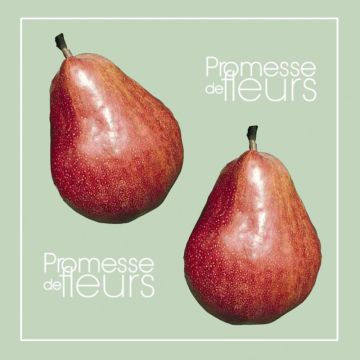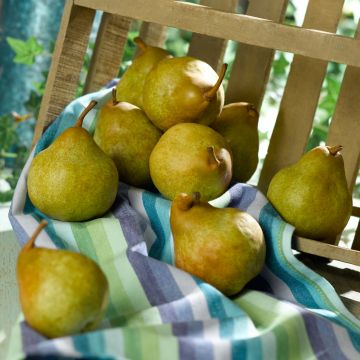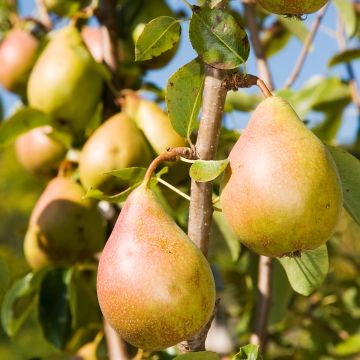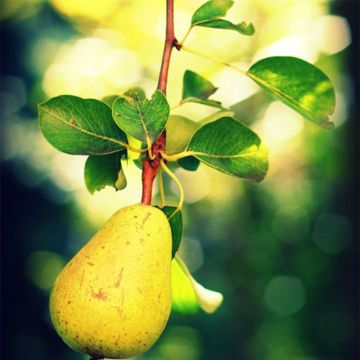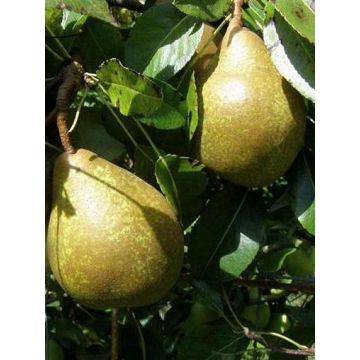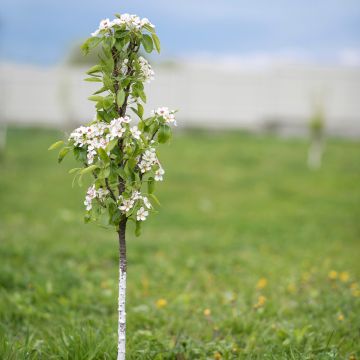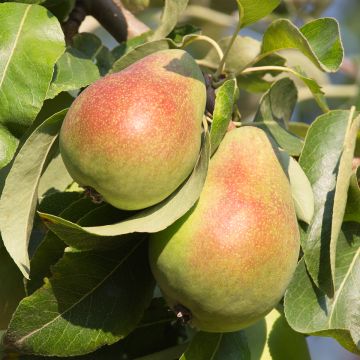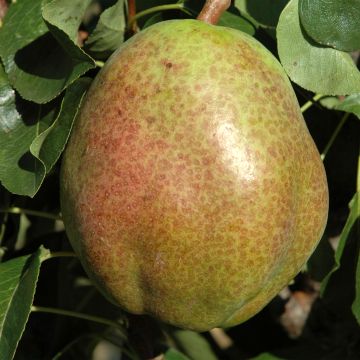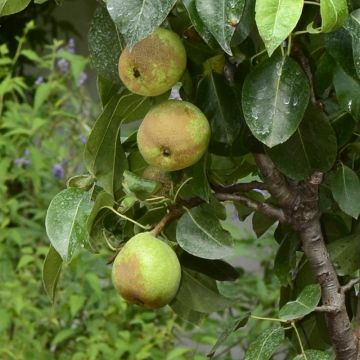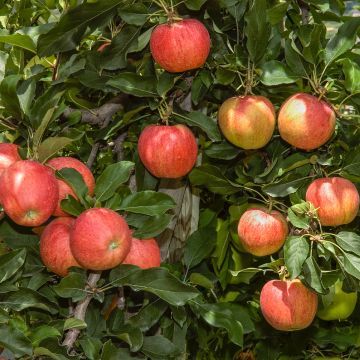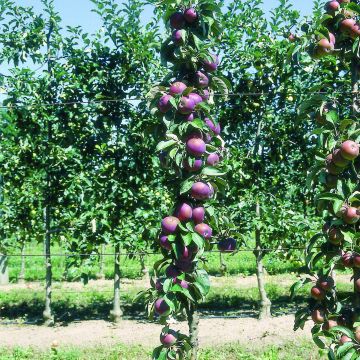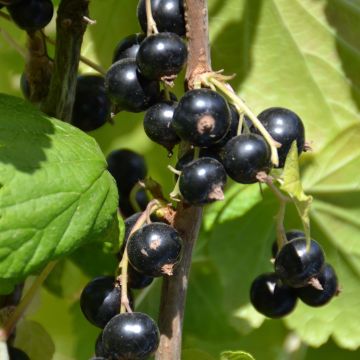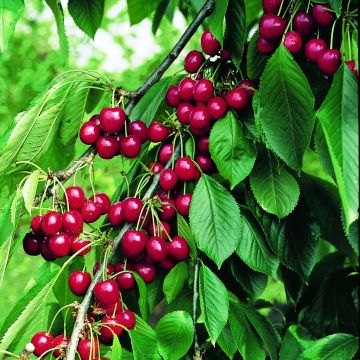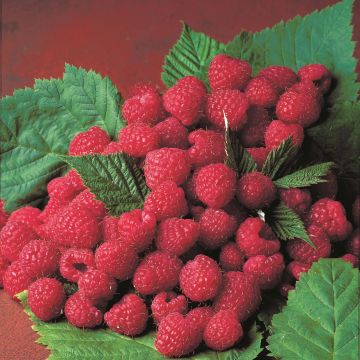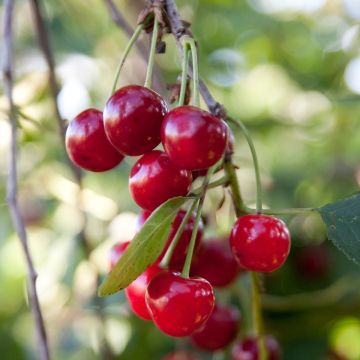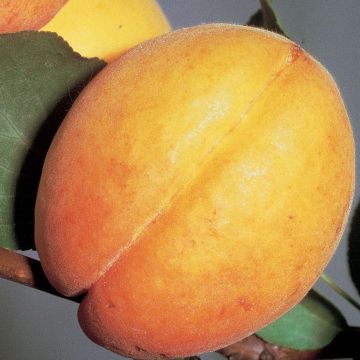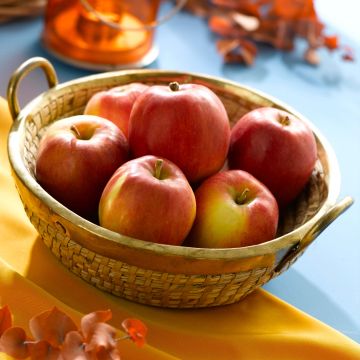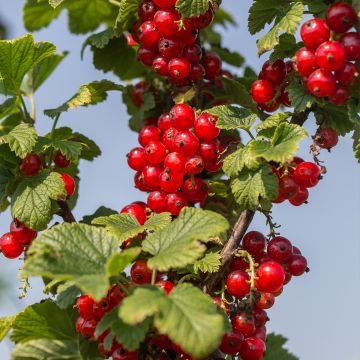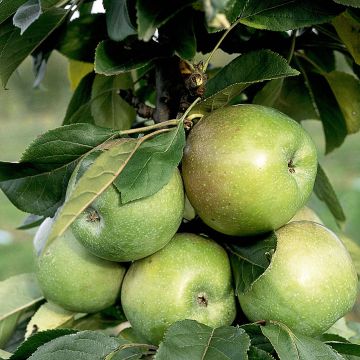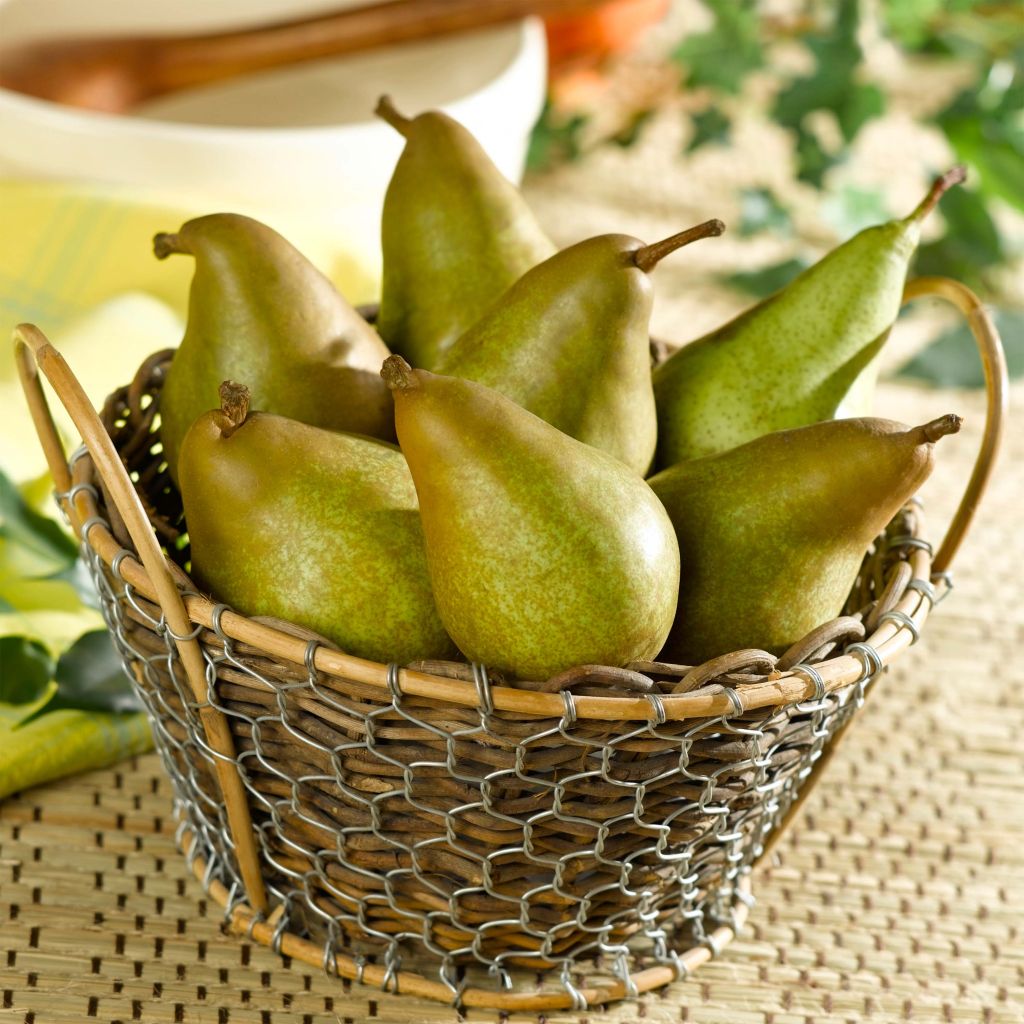

Pyrus communis Delbard Gourmande - Pear Tree
Pyrus communis Delbard Gourmande - Pear Tree
Pyrus communis Delbard Gourmande® delsavor
Common Pear, European Pear
This item cannot be shipped to the selected country
Delivery charge from €5.90
Delivery to Corse prohibited
More information
Schedule delivery date,
and select date in basket
This plant carries a 6 months recovery warranty
More information
We guarantee the quality of our plants for a full growing cycle, and will replace at our expense any plant that fails to recover under normal climatic and planting conditions.
From €5.90 for pickup delivery and €6.90 for home delivery
Express home delivery from €8.90.
Delivery to Corse prohibited: UE law prohibits the import of this plant from mainland France to Corse as part of the fight against Xylella fastidiosa. Please accept our sincere apologies.
More information
Description
The 'Delbard Gourmande'® (‘delsavor’) Pear Tree was created to celebrate the 60th anniversary of the Delbard house. It is an easy-to-grow fruit tree that enjoys regular productivity. The fruits, which have a flavour reminiscent of 'Doyenné du Comice', have a bronzed green skin and the advantage of good storage capability. Harvest takes place in October and storage can be extended for two or three months.
The pear tree is a tree native to central Asia, cultivated in China for 6,000 years. It was introduced to Europe around the 6th century. The leaves have an oval lamina, finely toothed at the edge, with a petiole as long as the lamina. The late white flowering occurs in April, protecting it from frost. Its flowers are formed of 5 white petals. Those of the 'Delbard Gourmande'® (‘delsavor’) pear tree are not self-fertile. 'Williams', 'Doyenné du Comice', 'Sucrée de Montluçon', as well as 'Fertilia Delbard'® are good pollinators, so plant one of these trees nearby or make sure there is one in the surrounding gardens.
This fruit variety is perfectly hardy and adapts to all types of soils as long as there is not excessive limestone. It appreciates fresh, deep, and well-worked soils. In winter, add a shovelful of wood ash, rich in potash, to the tree. It will improve flowering and fruit quality, a practice that you can extend to your entire orchard.
The 'Delbard Gourmande'® fruits have the oblong and classic shape of pears, and the skin is marked with bronze on a green background. It is in terms of flavour that this variety stands out, the balance between sweetness and acidity is very pleasant, and the finely granulated and juicy flesh has a hazelnut aroma. Consumed raw, it is delicious, and when cooked, it is a good candidate for making compotes or desserts in combination with dark chocolate.
For transport reasons, our tallest scions may be pruned before shipping. They are suitable for all common training sizes: cordons, espaliers, goblets, half-standards, and low standards, except for high standards. If you would like more information or advice on training your fruit trees, please do not hesitate to contact us.
This fruit tree is delivered in a "ready-to-plant" root ball. During planting, the root ball should be planted as is. The biodegradable tontine that surrounds the root ball and preserves the rootlets will decompose naturally during the growth of the plant. By doing so, you ensure better establishment.
Report an error about the product description
Pyrus communis Delbard Gourmande - Pear Tree in pictures
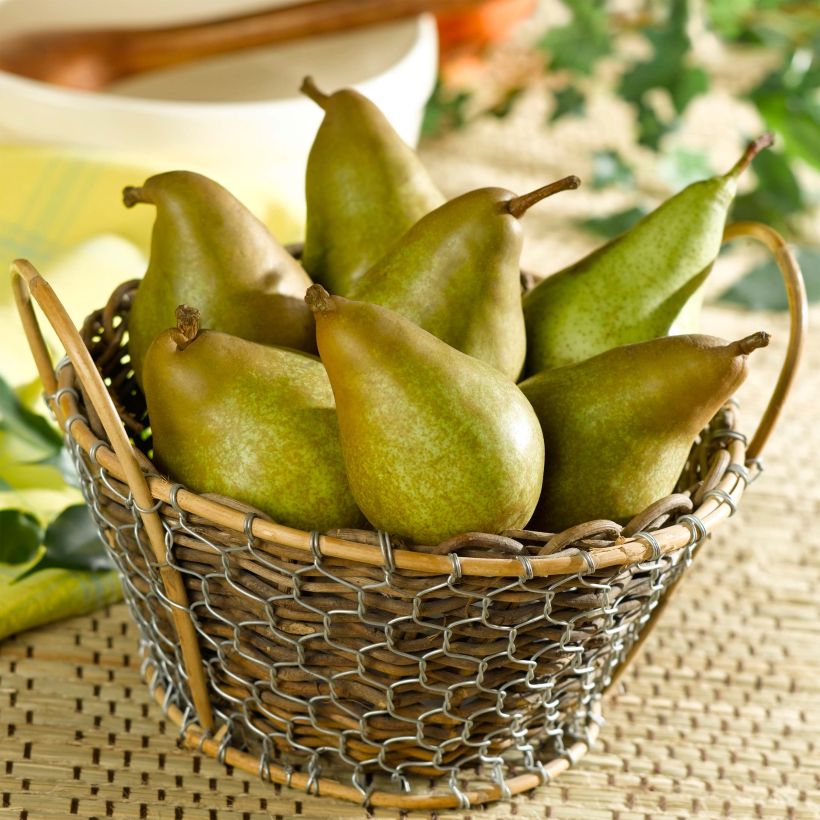

Plant habit
Fruit
Flowering
Foliage
Botanical data
Pyrus
communis
Delbard Gourmande® delsavor
Rosaceae
Common Pear, European Pear
Cultivar or hybrid
Quince BA29 (Ready-to-plant root ball - Goblet)
Other Pear trees
Planting and care
Plant the 'Delbard Gourmande'® ('Delsavor') pear tree in a sunny location, in neutral, acidic, or slightly alkaline soil, moist but not excessively so. Dig a hole two to three weeks before planting, twice as wide and deep as the pot. On planting day, place the tree with its pot in a basin of water, so that the entire root ball is moistened by capillary action. Ensure proper drainage in the planting hole by adding a thin layer of gravel at the bottom and top with well-decomposed compost. Install the tree in the hole, backfill with soil mixed with compost. Do not bury the graft union. Firmly tamp down the soil around the base. The root ball should be completely covered. Water generously. During winter, you can add a small handful of wood ash, rich in potassium, to improve fruiting. Spread it around the tree under the crown, but not directly at the base of the tree, as it would be ineffective.
Planting period
Intended location
Care
This item has not been reviewed yet - be the first to leave a review about it.
Georges Delbard fruit trees
Haven't found what you were looking for?
Hardiness is the lowest winter temperature a plant can endure without suffering serious damage or even dying. However, hardiness is affected by location (a sheltered area, such as a patio), protection (winter cover) and soil type (hardiness is improved by well-drained soil).

Photo Sharing Terms & Conditions
In order to encourage gardeners to interact and share their experiences, Promesse de fleurs offers various media enabling content to be uploaded onto its Site - in particular via the ‘Photo sharing’ module.
The User agrees to refrain from:
- Posting any content that is illegal, prejudicial, insulting, racist, inciteful to hatred, revisionist, contrary to public decency, that infringes on privacy or on the privacy rights of third parties, in particular the publicity rights of persons and goods, intellectual property rights, or the right to privacy.
- Submitting content on behalf of a third party;
- Impersonate the identity of a third party and/or publish any personal information about a third party;
In general, the User undertakes to refrain from any unethical behaviour.
All Content (in particular text, comments, files, images, photos, videos, creative works, etc.), which may be subject to property or intellectual property rights, image or other private rights, shall remain the property of the User, subject to the limited rights granted by the terms of the licence granted by Promesse de fleurs as stated below. Users are at liberty to publish or not to publish such Content on the Site, notably via the ‘Photo Sharing’ facility, and accept that this Content shall be made public and freely accessible, notably on the Internet.
Users further acknowledge, undertake to have ,and guarantee that they hold all necessary rights and permissions to publish such material on the Site, in particular with regard to the legislation in force pertaining to any privacy, property, intellectual property, image, or contractual rights, or rights of any other nature. By publishing such Content on the Site, Users acknowledge accepting full liability as publishers of the Content within the meaning of the law, and grant Promesse de fleurs, free of charge, an inclusive, worldwide licence for the said Content for the entire duration of its publication, including all reproduction, representation, up/downloading, displaying, performing, transmission, and storage rights.
Users also grant permission for their name to be linked to the Content and accept that this link may not always be made available.
By engaging in posting material, Users consent to their Content becoming automatically accessible on the Internet, in particular on other sites and/or blogs and/or web pages of the Promesse de fleurs site, including in particular social pages and the Promesse de fleurs catalogue.
Users may secure the removal of entrusted content free of charge by issuing a simple request via our contact form.
The flowering period indicated on our website applies to countries and regions located in USDA zone 8 (France, the United Kingdom, Ireland, the Netherlands, etc.)
It will vary according to where you live:
- In zones 9 to 10 (Italy, Spain, Greece, etc.), flowering will occur about 2 to 4 weeks earlier.
- In zones 6 to 7 (Germany, Poland, Slovenia, and lower mountainous regions), flowering will be delayed by 2 to 3 weeks.
- In zone 5 (Central Europe, Scandinavia), blooming will be delayed by 3 to 5 weeks.
In temperate climates, pruning of spring-flowering shrubs (forsythia, spireas, etc.) should be done just after flowering.
Pruning of summer-flowering shrubs (Indian Lilac, Perovskia, etc.) can be done in winter or spring.
In cold regions as well as with frost-sensitive plants, avoid pruning too early when severe frosts may still occur.
The planting period indicated on our website applies to countries and regions located in USDA zone 8 (France, United Kingdom, Ireland, Netherlands).
It will vary according to where you live:
- In Mediterranean zones (Marseille, Madrid, Milan, etc.), autumn and winter are the best planting periods.
- In continental zones (Strasbourg, Munich, Vienna, etc.), delay planting by 2 to 3 weeks in spring and bring it forward by 2 to 4 weeks in autumn.
- In mountainous regions (the Alps, Pyrenees, Carpathians, etc.), it is best to plant in late spring (May-June) or late summer (August-September).
The harvesting period indicated on our website applies to countries and regions in USDA zone 8 (France, England, Ireland, the Netherlands).
In colder areas (Scandinavia, Poland, Austria...) fruit and vegetable harvests are likely to be delayed by 3-4 weeks.
In warmer areas (Italy, Spain, Greece, etc.), harvesting will probably take place earlier, depending on weather conditions.
The sowing periods indicated on our website apply to countries and regions within USDA Zone 8 (France, UK, Ireland, Netherlands).
In colder areas (Scandinavia, Poland, Austria...), delay any outdoor sowing by 3-4 weeks, or sow under glass.
In warmer climes (Italy, Spain, Greece, etc.), bring outdoor sowing forward by a few weeks.

































